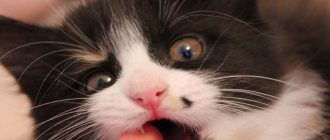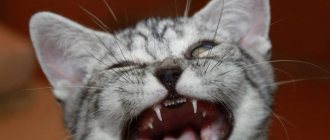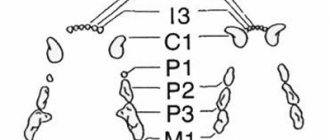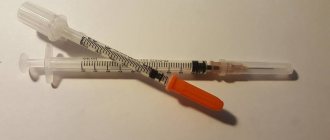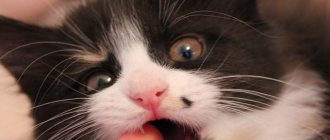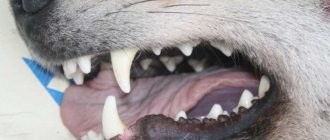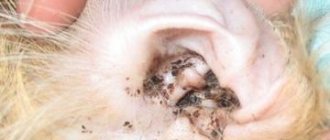Good hygiene is essential to maintaining the health of every pet. The main reason for the appearance of plaque is insufficient care of teeth and gums. The most common disease in every second cat is a lesion
tartar. Plaque does not cause cats much discomfort, but if measures are not taken, a dangerous disease can occur, including death. Therefore, brushing your cat’s teeth weekly is an important responsibility of every cat owner.
The need for oral hygiene
Cats belong to the order of predators. In the wild, the process of brushing teeth occurs naturally, because the cat's diet contains bones and cartilage of small animals and birds. They erase the plaque, and the teeth of wild predators remain white and smooth. Pets have a more varied menu, but it mainly consists of soft food. Many pets refuse to eat dry food, choosing pouches and pates. This causes plaque to remain in place and harden over time.
The stone is located on the neck of the tooth, in close proximity to the gums. Its gradual growth leads to the fact that the mucous membrane is injured and inflamed. If treatment is not started, a number of diseases may develop: caries, stomatitis, gingivitis, periodontal disease, osteomyelitis. The latter is characterized by purulent lesions of the jaw tissue, which can spread throughout the body. In this case, there is a risk of developing sepsis and death.
To prevent possible complications, all owners are recommended to perform hygienic cleaning of the oral cavity of their pets. The procedure should be performed at least twice a week.
Professional dental care
Professional removal of plaque and stones in a veterinary clinic is teeth cleaning with ultrasound.
This procedure allows you to completely remove plaque and tartar deposits from the entire dentition. The manipulation is performed with a special device - an ultrasonic scaler.
During this procedure, it is recommended to put the animal under anesthesia.
Why is anesthesia needed:
- To protect the animal from stress.
- To secure the animal.
- To avoid damaging the cat's oral cavity.
- To prevent water used for cooling from accidentally entering the trachea.
- To open the oral cavity as much as possible.
The procedure lasts from 30 to 60 minutes. 12 hours before cleaning, cats stop feeding; water is given for the last time an hour before the manipulation.
Process video
Tools and devices
To brush your cat's teeth, you will need toothpaste and a brush. Should cats' teeth be brushed with human hygiene products - under no circumstances! The paste will poison the animal, and the brush will damage the delicate gums.
Brush selection
Pet brushes vary in shape, size and material from which they are made. Pet stores sell:
- silicone models;
- with soft bristles.
The first ones are made in the form of a fingertip; instead of hairs, they have small teeth, which are used for cleaning. The latter differ from conventional brushes in the size and softness of the bristles. Some owners use toothbrushes designed for children in their first year of life. There are even those who brush their pets' teeth with regular gauze tied on their finger. The method is dangerous in the case of an aggressive cat, as it can bite a finger. It is quite acceptable for calm pets.
Toothpastes and gels
Toothpaste should be specifically designed for animals. Since pets do not know how to rinse their mouths, all residues are swallowed. Using simple menthol pastes on people can lead to severe food poisoning.
In order for the cat to more readily accept the cleaning manipulation, special flavors are added to the products (for example, meat or fish). Most often in pet stores you can find the following brands of drugs:
- Gel 8in1;
- Huts;
- FELINE HEALTH NUTRITION.
To remove the primary soft formation, you can purchase veterinary sticks for cleaning teeth. They are moistened with a special composition that softens and removes plaque.
What will be required for the procedure?
Cats have very sensitive and vulnerable gums. For this reason, regular toothbrushes are not recommended. In pet stores you can buy special kits with soft brushes that fit on your finger.
Such devices are very convenient for cleaning cat fangs and incisors, and most importantly, using them you can not be afraid of injuring your pet’s gums.
It is strictly forbidden to use ordinary toothpaste, since it is not only unsuitable for animals, but can also cause problems with the digestive system if accidentally swallowed.
Veterinary pharmacies and pet stores offer a wide selection of specialized products intended for oral hygiene of cats.
As a last resort, for the procedure, you can use a weak solution prepared on the basis of baking soda.
How does the procedure work?
It is not recommended to carry out manipulation without special training. If teeth cleaning for cats is the first time, you need to let the animal sniff objects that are new to it. You can offer to try the paste so that the taste and consistency are familiar to the cat. Thirty minutes before the start of the procedure, it is recommended to remove bowls of food and water.
Preparation
The first attempt to brush a cat's teeth may be unsuccessful if the pet is not accustomed to this. To prevent brushing your cat’s teeth from becoming stressful, and for the owner from becoming a traumatic procedure, you need to be well prepared:
- feed the cat 1.5-2 hours before the hygiene procedure;
- create a calm and quiet environment in your home;
- make sure in advance that the cat is familiar with all the cleaning items - brushes, bandages, a tube of paste;
- A particularly restless cat should be wrapped in a towel and held.
At first, you will most likely need an assistant. In the future, even one person can handle a cat accustomed to cleaning.
If the cat resists at the initial stage, it is better to let it go and let it calm down. A new attempt can be made later, when the animal is relaxed and friendly.
Direct cleaning
At first it will be unusual and difficult for you, but over time the procedure will become simple and fast. How to brush your cat's teeth yourself:
- Apply a little cleaning product to the brush;
- take the cat in your arms and place it on your lap with its back to you, trying to calm it down as much as possible;
- open your mouth with two fingers and slightly pull your lips to the sides;
- begin smooth movements without significant pressure from top to bottom, then along the entire dentition.
- If something bothers your pet or he doesn’t feel well, the procedure must be rescheduled for another day.
Brushing cats' teeth at home is contraindicated if they have oral diseases. These are inflammatory processes of the mucous membranes, bleeding gums, gingivitis, stomatitis, post-extraction alveolitis - inflammation of the hole at the site of the extracted tooth. It is necessary to approach the process with caution if your pet has a tendency to have epileptic seizures.
If, despite regular hygiene procedures, you notice a dark, hard plaque on your teeth that cannot be removed with a toothbrush, ultrasonic teeth cleaning is used.
Ultrasound cleaning of dental calculus is performed under general anesthesia in a veterinary office. It is not very cheap, but the stone is completely removed, and then you do not have to treat the cat for more serious diseases.
If the cat resists strongly
Since not every cat can brush its teeth, veterinarians allow several options for the hygiene procedure.
If a cat generally does not like violent actions, she will need a special retainer bag. The bag will help carry out regular procedures necessary for the health of the animal: cleaning eyes and teeth, combing, trimming nails, and medical treatment in case of illness. The cat will gradually get used to the bag and will not resist too much.
It happens that the main thing for an animal is to demonstrate its character. Then the owner needs to prove his authority and strength: you can tightly swaddle the cat and at least brush its teeth a little, thereby showing that you are serious. You should not shout, you need to talk to the animal in a firm, quiet voice. An adult animal understands human intonations perfectly and will reduce resistance in most cases.
If your pet is timid or begins to take revenge after every brushing of its teeth, you will have to look for an alternative. It will be more complicated and more expensive, but you cannot completely abandon hygiene - otherwise it will result in serious health problems.
Preparing the animal
Training a small animal is definitely easier than training an adult cat. In this regard, once the kitten is born, you should regularly set aside time for brushing your teeth.
Accustoming an adult pet to cleansing the mouth should be done gradually and correctly:
- You need to buy special hygiene products for the animal at the veterinary pharmacy. Human brushes and toothpaste are not suitable for cats, as they can damage gums and tooth enamel.
- Let your pet explore new items: sniff and examine. This will help him endure further teeth cleaning without panic.
- A few days before the procedure, you need to let the animal try the paste so that it is not frightened by new sensations.
- It is better to clean the oral cavity at a time when the cat has eaten and is about to sleep. At this moment, he will be as curious as possible, which can play in favor of the owner.
- If you have several pets living in an apartment, you will need to purchase an individual brush for each one to clean their mouth.
After completing the preliminary preparation, you can proceed to cleansing the oral cavity.
Frequency of manipulations
Veterinarians recommend carrying out a hygiene procedure 1-2 times a week, but many owners do not rest on this: should they brush their cat’s teeth more often? If the cat is already used to it and does not show aggression, then you can increase the frequency of procedures to 5-6 times a week, especially if the animal is prone to problems with the oral cavity.
The second controversial issue arises when comparing oral hygiene in humans and animals. People brush their teeth every day and still visit the dentist once every six months - for oral hygiene, fluoridation and other types of prevention. Does a cat need to have its teeth cleaned by a veterinarian if the owner does it regularly at home? No, it is not necessary if everything is fine with the animal. Professional laser cleaning is only necessary in case of tartar formation.
Symptoms of tartar
Day by day, the layers on the teeth accumulate, the lower layers turn into tartar, which irritates the gums and causes inflammation. The following signs will indicate that such a problem actually exists:
- swelling and redness of the gums;
- bleeding gums;
- increased salivation;
- putrid odor from the mouth;
Read more: What to do about bad breath from a cat
- yellowing of teeth;
Read more about this problem: Why does my cat have yellow teeth?
- loss of appetite;
- anxiety, sometimes even aggression.
To prevent the occurrence of dangerous diseases, Murkoshi specialists recommend carrying out comprehensive oral care and using special products to clean your cat’s teeth.
When and how to teach a kitten to brush its teeth
You should begin introducing your cat to the teeth cleaning procedure as early as possible - 2-3 months after the pet moves into your home. The process is quite simple and does not take much time:
- After he has eaten, the kitten is placed on his lap and begins to be stroked.
- The index finger is bandaged with gauze and soaked in meat or fish broth. The baby is invited to sniff it and even taste it without biting it with his teeth.
- After a few days, the procedure is repeated, but the finger is carefully inserted into the oral cavity. And after a week they begin to massage their gums. If you find yourself in the period of changing milk teeth to molars, then the cat will definitely not refuse such pleasure.
- After a month, a brush takes the place of the finger, and instead of broth, toothpaste with added flavoring is used.
Handle your pet carefully, without raising your voice at him. The kitten, frightened by unusual actions and the scream of the owner, may dislike the procedure.
Teaching a cat to brush its teeth
The kitten needs to be accustomed to the presence of the owner's finger in its mouth. For starters, you can lubricate it with something sweet. This will help the baby get used to the subsequent procedure.
To clean the oral cavity of a small animal, you can initially use special gels with disinfectant properties to freshen breath. Over time, you need to carry out the procedure using a toothbrush and toothpaste.
In order for the cat to get used to the taste of the new product, you need to lightly lubricate your pet’s nose with it.
An adult pet should also be accustomed to brushing its teeth, although this will require a long time, maximum patience and perseverance. Since the pet has already grown up, it will be more difficult for him to get used to some actions or to the presence of the owner’s finger in his mouth.
Alternative Cleaning Methods
Owners are not always able to brush their cat’s teeth because the animal behaves too aggressively or fearfully. For such cases, there are alternative methods: they are effective, but quite expensive - the cost of the funds varies from 250 to 2000 rubles. You can find them in a pet store or veterinary pharmacy:
- Special sticks and pads are designed to clean enamel from tartar, polish, whiten and give a pleasant smell. These delicacies are made from meat products with the addition of vitamins, grains and antiseptics.
- Liquid paste is designed to remove tartar and protect gums from bacterial growth. This product is suitable for kittens and cats of all ages. It is necessary to dilute 5 ml of liquid in 300 grams of water and give it to the cat daily. The only drawback of this convenient method is the high price (around 1000 rubles).
- The veterinary spray is applied to the gums and teeth. Its disadvantage is that the cat still needs to be held tightly, but the owner is spared the work of using a toothbrush.
- Dental hard food helps strengthen teeth and protect the oral cavity. Consist of vitamins, microelements, grains and meat products. Solid granules clean and polish the enamel, removing plaque. The main thing is to remember to offer your cat plenty of fresh water.
- Special toys are designed for kittens: when baby teeth are replaced by molars, the baby experiences discomfort and constantly needs to chew on something. The toy is perfect for these purposes - it does not damage the gums and helps cope with itching.
Do cats need to have their teeth brushed at the veterinary clinic if none of the alternative and traditional remedies work? Definitely - as soon as a hint of tartar appears, you need to visit a veterinarian. He will put the cat under anesthesia and clean his teeth with an ultrasound.
Tips for cleaning your cat's mouth
The best option is to teach your pet to clean the mouth from childhood. The animal will get used to it and will not hide when it sees the owner with hygiene products in his hand.
Here are some recommendations for the procedure:
- The cat must get used to the owner's hands. To do this, you can feed the kitten by hand, and in the process touch the teeth;
- After the baby gets used to it, you can start wiping the tooth enamel with wet wipes. It is recommended to give your cat a treat before and after cleaning as encouragement. As an alternative, you can purchase a vitamin stick at a pet store - it is both a treat and beneficial for the oral cavity;
- When cleaning your teeth with a brush, it should be tilted at an angle of 45 degrees, and not vertically. Cleaning is carried out with gentle up and down movements on each side;
- The duration of the first procedure should be approximately 10 seconds for each row. Subsequently, the time increases to 30 seconds;
- Cleaning the gums is prohibited, especially with a hard brush, so as not to cause injury. There may be bleeding at first, but it will stop over time.
Do not forget that in natural conditions animals do not clean their mouths, so manipulation must be carried out very carefully.
Hygiene equipment
How to brush your cat's teeth? To complete the cleansing procedure, it is worth remembering all the necessary accessories. In addition to toothpaste, you need to purchase a soft toothbrush, powder or cleansing gel.
Toothbrush
How to clean a cat’s ears at home: options for how and what to wash with
There are several types of brushes that are used to clean the oral cavity of pets:
- A special brush that fits on your finger. One of the most inexpensive products, which costs around 100 rubles. This brush cleans the mouth well of plaque. However, it is considered an unsafe option, since in the process the cat may bite the owner’s finger due to a not very pleasant procedure.
- Liquid brush. Used without toothpaste. It quickly removes plaque and whitens the animal’s teeth. Similar products cost around 1000 rubles.
- Regular brush. In appearance it is similar to a human one, but is more compact in size. There are various brush heads that help remove food particles from your mouth.
Important! Before choosing equipment, you should consult your veterinarian. He will conduct an oral examination and make his recommendations.
Toothpaste or tooth powder
Toothpaste for kittens
It is worth choosing your toothpaste responsibly. Experts advise choosing a mint-flavored paste to make the cleaning process more comfortable.
Good products must include bone meal, glycerin, and enzymes. These substances help to gently rinse the mouth without scratches or damage.
There are several types of toothpastes for cats:
- Medicinal. Used as a course in the presence of oral diseases in cats.
- Preventive. Used to prevent the development of dental pathologies.
- Powder pastes. Use for regular use. Such products remove stuck food from teeth and cleanse plaque from enamel.
Products in powder form contain mineral components that help maintain the integrity of teeth and gums. Some veterinarians advise adding powder pastes to food. They help clean the oral cavity and prevent the development of germs and bacteria. These products do not contain caustic components, do not give off odor or taste, so pets will not even notice its presence in food.
It is worth considering that powder products are used in a strictly specified dosage.
Cleansing gels
Special oral gels are hypoallergenic products that fight inflammation of the oral cavity, reduce plaque and caries. A huge advantage of such products is that there is no need to use toothpaste. Such products are created from natural ingredients; they do not contain aggressive particles or flavors, so they do not cause allergies and are well absorbed by cats.
The spectrum of action of gels is wide:
- plaque removal;
- reduction of tartar;
- disinfection of the oral cavity;
- elimination of unpleasant odor;
- removal of bacteria and parasites;
- relieving the inflammatory process.
Important! Veterinarians recommend using gel-like products several times a day. After 1-2 months of intensive therapy, the frequency of procedures is reduced several times.
Tooth extraction
In advanced cases, the veterinarian prescribes surgical removal of a weak or diseased tooth. Surgery is required if the following diseases are diagnosed:
- periodontitis;
- abundant tartar;
- false or true polydenty;
- destroyed incisors;
- periostitis;
- malocclusion resulting in crowded teeth;
- odontogenic osteomyelitis.
However, there are also contraindications in which surgical intervention will only worsen the general condition of the animal. Affected molars are not removed if infectious diseases, temperature deviations or exacerbation of chronic diseases are detected.
After the operation, for the first time the pet is in the hospital, where it is monitored by veterinarians. After anesthesia, the cat will be disoriented and will need time to recover. The pet is allowed to eat after a few hours
The diet changes and consists only of soft food, whether it is spiders or natural products. After eating, the oral cavity is treated with an antiseptic
Brief conclusions
An important point: when carrying out manipulations, do not raise your voice or use force - this will forever discourage your pet from participating in dental procedures:
- Experts recommend using sprays - it is convenient and practical.
- Preventative foods labeled dentaL are an alternative to toothbrushing. But it is better to alternate cleaning and feeding. The modern range of domestic and imported production includes a sufficient amount of affordable feed that meets the requirements and standards.
- Don’t forget to feed your cat cartilage and soft bones from the vertebrae and chicken neck; it is useful to include grated raw vegetables (for example, carrots) in the diet - choose based on your pet’s gastronomic preferences.
- Special toys have been developed for cleaning kittens' milk teeth. When a baby replaces its first teeth with permanent ones, it often chews on something. An excellent option is large (so as not to swallow) soft rubber toys. They do not damage the gums, relieve itching, and partially clean the enamel.
- A varied, natural diet also reduces the risk of dental problems in cats.
- Do not try to feed the animal bony fish or large and sharp bones of cattle - make sure that the cat does not injure the mouth and does not create favorable conditions for the development of bacteria in the oral cavity. Veterinary experts recommend visiting a “cat dentist” at least once a year – it’s easier to deal with tartar in the early stages.
Insufficient care of a cat's tooth enamel results in unpleasant oral diseases, a putrid odor, gastrointestinal disturbances and overall longevity and health of the pet. If you love your tailed friend, you probably have an extra minute for hygiene procedures for your pet.
Over time, this will become a tradition and will not burden either you or the cat, and the result will definitely justify the effort. Don’t be lazy and don’t be afraid to take care of your cat’s teeth – he will only be grateful to you.
Using home remedies for cleaning
Ideally, oral hygiene involves the use of special products designed for pets. But they are not always at hand.
At home, the procedure can be carried out using wine and soda. These products help remove food debris and stone formation.
First, the teeth are moistened with wine, then soda is applied. The components react with each other and purification occurs.




